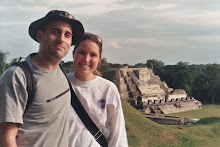We took the kids around the island, which doesn't take long since it is an extremely small island, on a vegetation walk. The kids were able to see the Australian pine, Coconut trees, Royal Palms, Traveler's Palms, and other varieties of trees. They were also shown different types of legumes.
On the east side of the island, the students got an upclose and personal lecture on mangroves and their importance to the tropics.
After the walk, we had lunch and divided the kids up into two groups to take them out over the
shallow lagoon on the east side of the island.
Here the kids were able to experience coralline algae, turtle grass, segmented worms, brittle sea stars, a sea cucumber, along with other organisms that use this shallow environment.
The kids were able to see a large variety of healthy coral, sea fans, sponges, and fish. They were also able to see the flamingo tongue snail after I pointed it out to them. Also planned for that night, after our night lecture, was the night snorkel at the south end of the beach. Several students opted not to do the night snorkel but after they felt the excitement from the others that were going, they headed out with us. I told them that I would lead them out and lead them back. They were required to pair up with a buddy and to attach a light stick to their snorkel so those on the beach could keep track of us. We had a boat in the channel so that we wouldn't swim into it and get caught in the current. For night snorkels, there wasn't much out but the kids did have a good time and those that decided to go, were proud of themselves for doing it.





















No comments:
Post a Comment